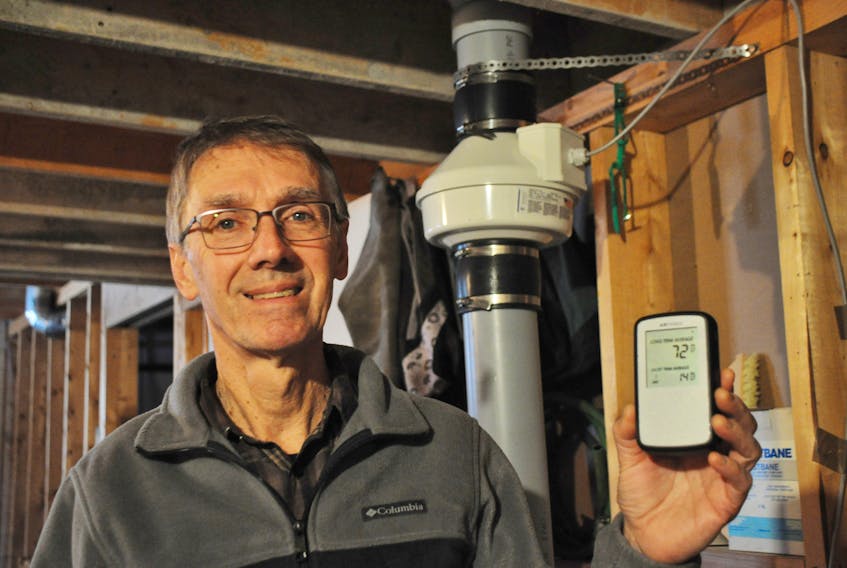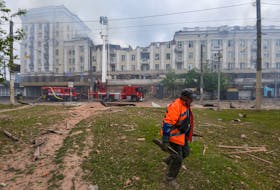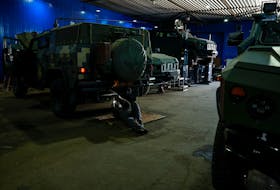KIPPENS, N.L. — FRANK GALE
THE WESTERN STAR
KIPPENS
After discovering high radon levels in his home in Kippens and fixing the problem, Bill Alexander wants everyone to be aware of the potential hazard and get their homes tested.
He learned about the potetial harmful effects of radon gas from his brother David Alexander, who lives in the St. John River Valley, New Brunswick — an area susceptible to high levels of radon.
While building a new house there, David had a radon mitigation system installed, which is written into the building code for his location.
After learning that, Bill purchased a meter to test his own home and was surprised to get readings that had levels four and a half times the National Canadian Safety Level of 200 Becquerels per metre cubed (Bq/m³).
He said the radon readings in his basement were six times the World Health Organization’s safe level.
Radon comes from uranium in the soil as it decomposes. The gas infiltrates people’s homes in various ways and tends to be at highest levels in the lowest level of a home.
“In newer homes, many residents have recreation rooms and bedrooms in their basements, so that’s concerning. Single level, slab-on-grade homes can be particularly at risk,” he said.
With the guidance of the Canadian Association of Radon Scientists and Technologists (CARST), Alexander installed a radon sub-floor depressurising fan and ventilation system in his house.
He has been monitoring the radon levels since installing it earlier this year and they have dropped dramatically to a safe level of five per cent of the national safety level.
What’s concerning for him is that, using the detector he purchased, he has tested several homes in the Kippens area and 50 per cent of them were high.
“I’m suspect our geology could produce higher than average radon levels, like what’s being experienced in the area of New Brunswick where my brother lives,” he said.
Alexander said there is an aggressive radon awareness program in Nova Scotia, which includes a detector loan program in provincial libraries.
Alexander doesn't knows of any radon programs in Newfoundland and Labrador and believes overall awareness is very poor. He feels this is leaving people at risk.
Alexander said it was due to his interest in radon, that CARST will be providing 100 long-term detectors for homes in the Bay St. George region next November.
Erin Curry, regional director at CARST out of Saint-Lazare, Quebec, agreed with Alexander that all homes should be tested for radon.
She said Alexander will be talking with towns in the area to conduct the test to determine the risk for homeowners in the region. She feels its also important to get municipalities on board.
“Through the program, we should get a much better picture towards the radon levels in homes in the area,” Curry said.
[email protected]
What is radon?
• Radon is a radioactive gas that comes from uranium in the ground and can get into your home undetected. You can’t see it, smell it or taste it.
• All homes have some level of radon, but only a small percentage will have radon levels above the guideline. The only way to know is to test.
• In confined spaces like a house, radon can build up to high levels and over time become a health risk.
What are health risks?
• Radon exposure is the No. 2 cause of lung cancer, after smoking. Sixteen per cent of lung cancers are estimated to be from radon exposure, resulting in more than 3,200 deaths in Canada each year.
• People who smoke and are exposed to radon have an even higher risk of lung cancer.
• The health risk from radon is long-term, not immediate.
Source: Health Canada
How to test a home for radon?
• Testing for radon is easy and inexpensive.
• Testing can be done by purchasing a do-it-yourself radon test kit or by a measurement professional certified under the Canadian National Radon Proficiency Program (C-NRPP).
• Radon levels in a home can vary significantly over time, so you need to do a long-term test — for three months, ideally during the fall or winter time.
• Go to TakeActiononRadon.ca/test to find a test kit or certified professional.
What to do about high radon levels in a home
• Techniques to lower radon levels are effective and can save lives. Radon levels can be reduced by more than 80 per cent for about the same cost as other common home repairs, such as replacing the furnace or air conditioner.
• The higher the radon level in your home, the sooner it needs to be fixed.
• Hire a certified radon mitigation professional to help you find the best way to reduce the radon level in your home. The most common radon reduction method is active soil depressurization.
Source: Health Canada
Surprised by the high levels of radon in his Kippens home, Bill Alexander believes every home should be tested

STORY CONTINUES BELOW THESE SALTWIRE VIDEOS








